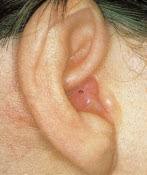Eczematous Otitis Externa.
Eczema of the meatus and pinna (see picture below) may be associated with eczema elsewhere, particularly in the scalp, or it may be an isolated condition affecting only one ear.
Itching is the main symptom, with scanty discharge.
The eczematous type of otitis externa usually settles with the use of a topical corticosteroid and antibiotic drop. Cleaning of the meatus may also be necessary, either with cotton wool on a probe, or
suction and the Zeiss microscope. Otitis externa tends to recur.
A Furuncle In the Meatus
A furuncle in the meatus is the other common type of otitis externa. It is characterized by pain; pain on movement of the pinna or on inserting the auriscope is diagnostic of a furuncle.
Diabetes mellitus must be excluded with recurrent furuncles.
Furunculosis.
This is a generalized infection of the meatal skin. Pain is severe and the canal is narrowed or
occluded so that examination with the auriscope is extremely painful and no view of the deep meatus is possible.
A swab of the pus should be taken, and treatment is with systemic antibiotics and a meatal dressing (e.g., glycerine and ichthyol, or a corticosteroid cream with an antibiotic).
The organism may be transferred by the patient’s finger from the nasal vestibules, and a nasal swab is a relevant investigation, particularly with recurrent furuncles. The lymph nodes adjacent to the pinna are enlarged with a furuncle or furunculosis, and a tender mastoid node may mimic a cortical mastoid
abscess.
Chronic Otitis Externa
Persisting for years may eventually lead to meatal stenosis and rarely to closure of the ear canal.
“Deep” Otitis Externa.
An uncommon form of chronic otitis externa involves predominantly the skin of the deep bony meatus and the surface of the tympanic membrane. The drum epithelium may become replaced with
sessile granulations (granular myringitis) infected with Pseudomonas pyocyanea.
In protracted cases of this type of otitis externa, the skin of the deep meatus and drum becomes thickened and “funneled” with meatal atresia.
The resulting conductive hearing loss is extremely difficult to treat surgically once this condition is quiescent.
“Malignant” Otitis Externa
It is a rare and serious form of otitis externa to which elderly diabetics are particularly susceptible. Granulation tissue is found in the meatus infected with Pseudomonas and anaerobic organisms. This granulation tissue tends to erode deeply, involving the middle and inner ear, the bone of the skull base with extension to the brain, and also the great vessels of the neck.
If uncontrolled, the condition may be fatal.
Intense antibiotic therapy sometimes associated with surgical drainage of the affected areas is necessary.
It is not a “malignant” condition in the histological sense, for the biopsies of granulation
tissue show inflammatory changes only. “Necrotizing” otitis externa may be more accurate, but “malignant” indicates the serious clinical nature.
Bullous Otitis Externa (Bullous Myringitis).
This unusual otitis externa frequently follows influenza or an upper respiratory tract infection. A
complaint of earache followed by bleeding, then followed by relief of pain is diagnostic of this condition.
Examination shows hemorrhagic blebs on the drum and meatus, similar to the vesicular eruption of herpes.
If there is pyrexia with a conductive hearing loss, the otitis externa is associated with an otitis media, and systemic antibiotics are necessary. In the absence of pyrexia and hearing loss, this condition settles spontaneously without treatment.
Otitis Externa With Herpes Zoster.
Otitis externa occurs with herpes zoster involving either the gasserian or geniculate ganglion, and the vesicles may be hemorrhagic.
Osteomas.
White, bony, hard swellings in the deep meatus are a common finding during routine examination. They usually remain small and symptom free, and tend to be symmetrical in both ears.
Swimmers are susceptible to these lesions, which are sometimes called “swimmer’s osteomas.”
Histologically, these bony lesions are hyperostosis, rather than a bony tumor, so that the term “osteoma,” although established, is not strictly correct.
Large osteomas may narrow the meatus to a chink so that wax accumulates
and is difficult to syringe. Otitis externa is also a complication.
These osteomas, therefore, may require surgical removal with a microdrill.









I started on COPD Herbal treatment from Ultimate Health Home, the treatment worked incredibly for my lungs condition. I used the herbal treatment for almost 4 months, it reversed my COPD. My severe shortness of breath, dry cough, chest tightness gradually disappeared. Reach Ultimate Health Home via their website at www.ultimatelifeclinic.com I can breath much better and It feels comfortable!
ReplyDelete